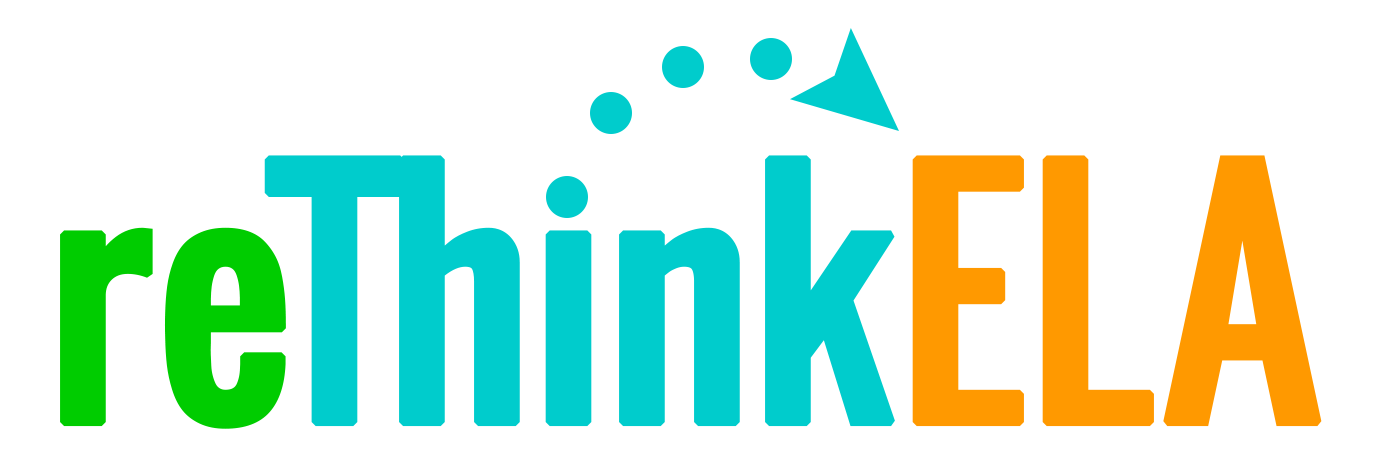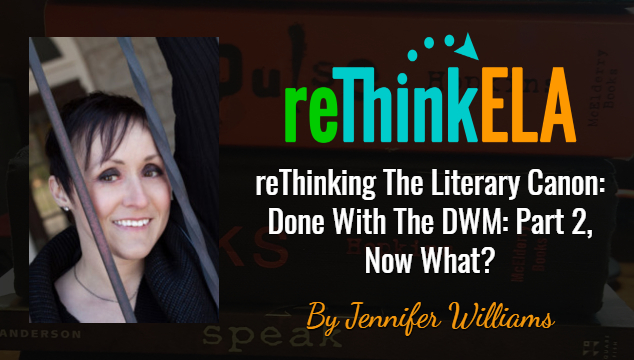Editor’s Note: Since Jennifer wrote this article two years ago, much has changed in the young adult literature landscape, including the addition of two amazing resources for finding diverse books for our students to read. We will update this article during Summer 2020. While you’re waiting though, check out #DisruptTexts and #WeNeedDiverseBooks on Twitter.
In Part 1 of my article for reThinkELA, I discussed how I arrived at my decision to stop centering the dead White guys. For Part 2, I thought I’d address some of your potential concerns and how to begin changing. For Part 3, I’ll probably discuss alternates to the Canon and/or how to decenter the DWM. Let’s begin…
The first protest I can imagine is, “But what about our common heritage or the common knowledge? Isn’t it great when we all can have the same allusions? It’s so cool how we all just know we pretty much read the same works, across America, in the same grades.”
I have two major issues with this line of “reasoning”:
- How many of you threw a hissy fit about Common Core and the possibility every state would have the — Gasp! — same standards? (Clutch your pearls right now.) How many of you were horrified by the “recommended” reading lists provided by CC? Now you’re worried that by changing the Canon we might lose a common heritage? Stop. Just stop. Think about what you were/are truly upset about. Is it really about losing that common knowledge or are you afraid of moving out of your comfort zone?
- Why does that common heritage have to be mostly White, cishet men? Why can’t we have a common heritage based on Sherman Alexie, Louis Eldrich, Roxanne Gay, Ashley Hope Perez, Alice Walker, James Baldwin, Tahereh Mafi, Sandra Cisneros, Julia Alvarez, Khaled Hosseini, Marjane Satrapi*… the list goes on. You are limiting yourself and your students by only holding up one mirror. In one of my grad school papers, I wrote about this same topic. I was proud of this sentence: “We need literature that opens doors for students—not literature that slams doors in their faces. It is past time we create a new common heritage, paradoxically built with diverse voices.”
And please don’t come at me with “But I’m using those DWM to show my non-White (non-straight/non-Christian/non-whatever) students another perspective. I’m using the DWM as a window.”
(insert some side-eye)
Yeah, your “other” students are fully aware of that White world. Just because you are clueless about their lives doesn’t mean they don’t completely understand your White privilege. They get Whiteness in ELA, history, math, science, art, etc. So stop with your fallacious excuses.
If you’re determined to hang onto those DWM, at least explore their lives. Some of them were gay or bisexual—don’t be afraid to discuss the impact of them having to, mostly, hide that side of themselves. How did that play out in Oscar Wilde’s work? Truman Capote’s work? Tennessee Williams’ work? Hell, there’s even still speculation about Shakespeare. Maybe discuss how that does, or doesn’t, impact his work. We worship him in the West. How cool would it be for your gay or bisexual students to possibly see their lives mirrored in freaking Shakespeare?
The second protest I would probably hear is, “What about materials? It’s hard writing lesson plans/assessments/tests. Are you telling me I have to start fresh?”
Are you kidding me? You have time in the summer. That’s when we do PD and other work. Next summer, grab a book you’ve never read before, one with potential for your class. First, Google and see if anyone else has already tackled lessons. If not, then jump to it. Now is the perfect time to breath some new life into your classes. And begin actually touching more of your students’ lives.
I didn’t say you had to immediately rewrite your entire year (although I’d be okay helping and supporting you in that); I’ll let you get your feet wet.
If you have to get district approval, start now. Here are some steps:
- Research and choose a book. That’s right, just one book. No, don’t start with a poem or short story. That’s too small and reeks of tokenism (simply making a symbolic effort). Choose a book.
- Read and annotate the book. Your annotations don’t have to be as ludicrous as you force your students to do—just think about your classes as you read the book.
- What would you point out to your students?
- What questions do you, or would they, have?
- What do you need to learn more about?
- Now, type up a justification for teaching this book.
- Where would you use it during the year?
- What would you take out?
- What standards does it help you teach?
- What problems might you encounter (e.g. any controversial issues or trigger warnings)?
- Would you need parental approval? (Sigh, you might if you’re not teaching the same pieces the parents and grandparents and great-grandparents read in school. One day, this won’t be an issue because White parents won’t be afraid of that scary word: diversity.)
- Would you provide an alternate assignment for anyone who doesn’t get approval?
- What supplemental pieces might you use with the piece (that might just be for your notes)?
- Finally, and most importantly, why are you teaching THIS piece? If you need help justifying, contact me. I can justify anything. 😉
- Take it through the proper channels. Bonus points if you are actually trusted enough to make your own choices for your classroom; however, at least let your department chair and principal know in case there is any pushback.
- Find resources. Does your department or district have money? Can you do a DonorsChoose? Can you buy used books (www.betterworldbooks.com can be useful if you plan ahead)? Sometimes Scholastic has great sales. I got copies of All American Boys for $3 each last semester.
- Now comes the fun part: lessons! Treat it like you would any other book, but—and I can’t stress this enough—make sure you know what the hell you’re talking about. If you’re a White woman teacher, and you’ve decided to tackle All American Boys, make sure you’re ready to discuss Black Lives Matter and the very real issue of Black and Brown people being disproportionately targeted by law enforcement…and many of them being murdered for no other reason but their skin color. If you’re hesitant, research the issues addressed in the book. Read. Talk to people. Screw up. Make changes. Ultimately, be prepared to make mistakes in class and own those mistakes. It’s better to be called a racist and change what you did wrong than to continue to be a racist.
- Yes, also discuss this with your White students. White people created this system. It’s past time we actually worked to change it. We have too many students suffering for our complacency and silence.
Now, you’ve been charged with a mission. You can no longer stick your head in the sand and pretend you don’t know.
Marginalized groups have been crying out for years. We must listen and change our curriculum. The lives of our future students partially depend on our choices. Because our choices in education fuel the rest of society. Will we rise and meet the challenge, or will we continue to shove too many of our students onto the margins?
It’s time to jump into the conflict and begin enacting change. Hey, don’t worry. You aren’t alone. More people will support you than try to thwart you. It’s now or never.
And, if you choose “never,” you also need to rethink your career choice. Too many students will be affected by your decision, and this fight is much too important to our society.
It’s time to educate ALL our students.
Join us, and #reThinkELA.
*Yes, I mentioned several YA authors in this list. But, that’s a topic for another post.


I am truly inspired by this. I plan on accepting the challenge!
Glad to hear it! We are working on more articles, including book reviews, to help you find more relevant texts that your students can both enjoy and connect with.